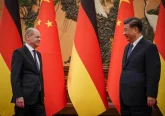
When journalists at the Southern Weekly newspaper in China’s Guangdong province went on strike last week against a local censor, Chinese citizens and the international media alike sat up and took notice. Microblogs amplified the journalists’ demands and helped make the incident a national topic of debate. Foreign commentators drew parallels to 1989, suggesting this could be the start of bigger protests.
But the deal quickly reached between Communist Party officials and the striking journalists shows that the system of media control is still very resilient. The reporters agreed to go back to work, and in exchange they received promises that their work wouldn’t be censored as heavily. The local propaganda chief wasn’t sacked, however, as they had demanded.
In other words, Southern Weekly was simply negotiating the boundaries for permissible reporting. Chinese journalists from the more outspoken outlets, like the business publications Caijing and Caixin and including Southern Weekly, have long done so. These negotiations are usually handled out of public view.
A rare exception occurred in 2005, when staff at Beijing News went on strike against their editor’s removal, after the publication exposed a sensitive corruption case in Hebei province outside Beijing. If Southern Weekly managed to kick up a bigger storm than Beijing News, it was thanks to the microblog and global-media attention.
Judging by this attention, you’d think a new antiregime movement was in the cards. But Southern Weekly, while reputable for its daring reporting, was never an opposition paper. My own work on this publication’s coverage of major crises, such as the 2008 Sichuan earthquake, shows that it consistently avoided confronting the central authorities. Its stories on the post-earthquake schools scandal targeted only local officials and were constructive in character, rather than solely critical.
My interviews with former and current Southern Weekly reporters confirmed that they saw themselves as change-makers but ultimately insiders. “A lot of Western commentators mistake us for rebels or dissidents, but we are also part of the system,” commented a former journalist.
So what happened this time? The journalists’ strike reflected accumulated frustration over what they saw as increasing interference into their editorial decisions. At the end of July, Southern Weekly was stopped from printing an in-depth human-interest story about the fatal rainstorms in Beijing. Around that time, a few reporters also left the paper, partly due to the changed political climate.
Consider what occurred in this tense environment. Guangdong’s top censor, Tuo Zhen, didn’t like the New Year’s editorial that called for constitutional rule of law. Southern Weekly’s editors capitulated and agreed to a second draft, but Mr. Tuo published a third draft that editors hadn’t seen. On top of that, the censors used one of the paper’s microblog accounts to claim that the published editorial was the editors’ own work.
That was the last straw. The journalists decided to strike. They may have also perceived a political opportunity because of November’s leadership transition.
These journalists, however, did not confront the Central Publicity Department or the Party-state in Beijing. After a few days of protest, when the journalists quietly settled the dispute with local authorities, some netizens were outraged that they hadn’t explained their decision to their supporters. One Southern Weekly edition last week reprinted an editorial first published by People’s Daily, the Party mouthpiece, which suggested that Beijing’s media management should be more modern but shouldn’t be completely abandoned.
It is also important to note the docile attitudes of other Chinese media outlets during this incident. Traditional media remained silent, while journalists didn’t organize any support.
The only exception was Beijing News, which initially refused to publish an editorial by Global Times—the commercial offshoot of the People’s Daily—that blamed the censorship protests on foreign activists. It was eventually forced to reprint the piece.
The Communist Party also didn’t clamp down in an unprecedented way. It appeared responsive to the protesters’ grievances while continuing to suppress public dissent. Instead of shutting down the paper, it yielded to some of Southern Weekly’s demands. This helped contain the scandal.
It remains to be seen whether this incident will embolden more Chinese media to protest against censorship, as some journalists on social media argue it will, or whether it will force them to censor themselves. The protest by Southern Weekly may be an unusual case of Chinese journalists’ resistance to censorship, but it isn’t a new dawn for freedom of speech or rebellion against the party.
Ms. Repnikova is a doctoral candidate in politics at Oxford University. She is writing her dissertation on state-media relations in China.
This post originally appeared as an op-ed in the Wall Street Journal and is republished here with the permission of the author and the WSJ.







No Comment